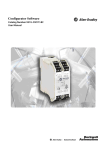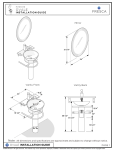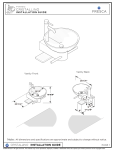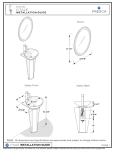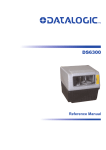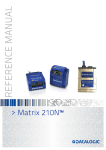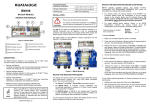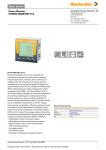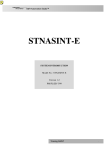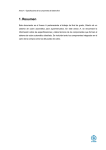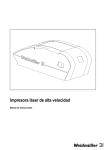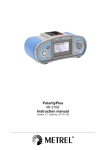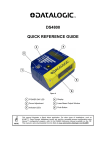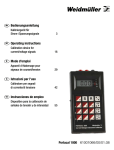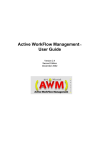Download WAVE TTA
Transcript
WAVE TTA User Manual Foreword Foreword Revision history Version Date Change 0.0 04/08 First edition Contact address Weidmüller Interface GmbH & Co. KG Postfach 3030 32720 Detmold Klingenbergstraße 16 32758 Detmold Germany Phone +49 (0) 5231 14-0 Fax +49 (0) 5231 14-2083 E-Mail [email protected] Internet www.weidmueller.com 5662300000/00/04.08 3 Contents Contents Foreword ............................................................................................................................3 Revision history................................................................................................................................................3 Contact address................................................................................................................................................3 Contents .............................................................................................................................4 1. Approvals...............................................................................................................7 1.1 CE........................................................................................................................................................8 1.2 UL........................................................................................................................................................8 1.3 GL........................................................................................................................................................8 2. Warrantee statement.............................................................................................9 2.1 36 months warranty ........................................................................................................................10 3. Notes on Safety ...................................................................................................11 3.1 Electrical precautions .....................................................................................................................12 3.2 Handling ...........................................................................................................................................12 4. Introduction .........................................................................................................13 4.1 Symbol identification ......................................................................................................................14 4.2 Types / article numbers ..................................................................................................................14 4.3 General description / applications / examples.............................................................................14 5. Operation .............................................................................................................17 5.1 Status & alarm LEDs .......................................................................................................................18 5.2 Functional block diagram...............................................................................................................19 5.3 Specifications ..................................................................................................................................20 6. Installation ...........................................................................................................23 6.1 General (Competence Warning) ....................................................................................................24 6.2 Mounting / Environmental / EMI protection / warm up ................................................................24 6.3 Marking.............................................................................................................................................25 6.4 Electrical Connections ...................................................................................................................25 6.5 Connection diagram........................................................................................................................26 4 5662300000/00/04.08 Contents 7. Setup / Configuration..........................................................................................29 7.1 Default setting .................................................................................................................................30 7.2 CBX100USB introduction ...............................................................................................................30 7.3 Configuration / diagram wiring ......................................................................................................30 8. TTA-Set software.................................................................................................31 8.1 Description.......................................................................................................................................32 8.2 Installation .......................................................................................................................................32 8.3 Starting/exiting TTA-Set .................................................................................................................32 8.4 Title bar ............................................................................................................................................32 8.5 Overview parameters ......................................................................................................................34 8.6 Run mode.........................................................................................................................................41 8.7 Product identification .....................................................................................................................41 8.8 Updates ............................................................................................................................................42 9. Testing the product.............................................................................................43 9.1 Test procedure ................................................................................................................................44 10. Troubleshooting..................................................................................................47 10.1 Troubleshooting ..............................................................................................................................48 Appendix ..........................................................................................................................49 Appendix A: Article Overview .......................................................................................................................50 Index ...........................................................................................................................................................51 5662300000/00/04.08 5 Contents 6 5662300000/00/04.08 Approvals 1. Approvals 1.1 CE........................................................................................................................................................8 1.2 UL........................................................................................................................................................8 1.3 GL........................................................................................................................................................8 5662300000/00/04.08 7 Approvals 1.1 CE CE Declaration is available from Weidmüller. 1.2 UL Listing approval (cULus) is pending. 1.3 GL Germanischen Lloyd approval is pending. 8 5662300000/00/04.08 Warrantee statement 2. Warrantee statement 2.1 36 months warranty ........................................................................................................................10 5662300000/00/04.08 9 Warrantee statement 2.1 36 months warranty Weidmüller gives a 36 months warranty on the Wave TTA product in accordance with the warranty terms as described in the general conditions of sale of the Weidmüller company which has sold the products to you. Weidmüller warrants to you that such products the defects of which have already existed at the time when the risk passed will be repaired by Weidmüller free of charge or that Weidmüller will provide a new, functionally equivalent product to replace the defective one. The warranty referred to above covers Weidmüller products. Safe where expressively described otherwise in writing in this catalogue/product description, Weidmüller gives no warranty or guarantee as to the interoperability in specific systems or as to the fitness for any particular purpose. To the extent permitted by law, any claims for damages and reimbursement of expenses, based on whatever legal reason, including contract or tort, shall be excluded. Where not expressively stated otherwise in this warranty, the general conditions of purchase and the expressive liability commitments therein of the respective Weidmüller company which has sold the products to you shall be applicable 10 5662300000/00/04.08 Notes on Safety 3. Notes on Safety 3.1 Electrical precautions .....................................................................................................................12 3.2 Handling ...........................................................................................................................................12 5662300000/00/04.08 11 Notes on Safety 3.1 Electrical precautions DANGER! This product may be connected to potentially lethal voltages! WARNING! • Before you remove or mount the unit, turn-off the power supplies – i.e. to the instrument and to the relays, if used. • Product electronics must not be removed from its enclosure without disconnecting power sources. • Follow ESD installation regulations, including the EMI precautions given in chapter 6. 3.2 Handling Check on receipt that the product received corresponds to the one ordered. Also check that a CD (which includes the User Manual and configuration software) has been supplied in the carton. Figure 1 Handling Unpack the product carefully, and ensure the CD/User Manual is kept with the product until it is permanently mounted. There are no procedures which involve the user removing the product electronics from its housing. Set-up or Re-configuration (see chapter 7) is via a connector located behind the front flap, which is released by small screwdriver (see Figure 1). 12 5662300000/00/04.08 Introduction 4. Introduction 4.1 Symbol identification ......................................................................................................................14 4.2 Types / article numbers ..................................................................................................................14 4.3 General description / applications / examples.............................................................................14 5662300000/00/04.08 13 Introduction 4.1 Symbol identification DANGER! Potentially lethal voltages. The CE mark proves the compliance of the product with the requirements of the directives. 4.3 General description / applications / examples Wave TTA is an accurate and stable signal converter / isolator / alarm generator for use in measurement and control systems. In one model, a wide variety of input / output range and type settings can be configured, using a separate (CBX100 USB) interface and (TTA SET) software. The TTA can be powered from DC or AC sources between 18 and 264 volts. This User Manual covers the following product types / article numbers The primary characteristic of the Wave TTA is its versatility of input / output configurability. Hence many of the standard functions performed by DIN rail mounted conditioners can be done by the TTA, such as WAS6 TTA 8939670000 • Conversion (current to voltage, and vice versa) WAZ6 TTA 8939680000 • Isolation of temperature sensor and DC inputs CBX100 USB 7940025031 • Linearization of temperature sensor inputs 4.2 Types / article numbers The only difference between the products is the connection type. The WAS6 TTA has screw connectors and the WAVZ6 TTA has tension clamp connectors. • Transmission of sensor signals over long distance • Characterising signals from DC transmitters • Process alarm generation • Relay control between high and low values can be done by the TTA. 14 5662300000/00/04.08 Introduction Typical Applications Typical of applications for the TTA is the conversion of thermocouple temperature input (low range of millivolts) into a high level (e.g. 4-20 mA) value for transmission to a control system. In this type of installation the TTA provides: • Linearization of the standard thermocouple temperature/millivolts characteristic. • Selectable output value for a thermocouple-break event. • Flashing LED status indicator on the unit front on thermocouple-break. • Relay alarm output if required on thermocouplebreak. • Relay alarm output on high or low process temperature. • Isolation of the input signal to the control system. This allows the user to use a thermocouple with a grounded hot junction for a quick response at the measurement point. This would otherwise convey electromagnetic influences (humming) into the control system. Figure 2 Installation overview 5662300000/00/04.08 15 Introduction 16 5662300000/00/04.08 Operation 5. Operation 5.1 Status & alarm LEDs .......................................................................................................................18 5.2 Functional block diagram...............................................................................................................19 5.3 Specifications ..................................................................................................................................20 5662300000/00/04.08 17 Operation 5.1 Status & alarm LEDs Status LED Under normal conditions this (green) LED is on continuously. Analogue Output status with alarm • User may select output value under fault conditions • Output compliant with NAMUR recommendations (NE43) can be set (<3.6 mA or >21 mA) Input fault detection Input faults such as short circuit or open circuit can be detected for most input types. These are shown in the table below. Input type A B C Figure 3 LEDs A Status LED Thermocouple Yes Yes RTD Yes Yes Millivolts Yes No Volts (Positive) Yes No Milliamps (Passive) Yes* No Milliamps (Active) Yes Yes Resistance Yes Yes Potentiometer Yes Yes** Table 2 B ALARM 2 * C ALARM 1 Detection Open circuit Short circuit Input fault detection Open circuit not detected for live zero ranges ** Short circuit for end-to-end The following table shows how alarm conditions are displayed. Status indicator Alarm conditions Normal status continuously on Input open circuit flashes at 0.5 Hz Input short circuit flashes at 5 Hz Cold Junction error 2 pulses, rests, 2 pulses Flash memory error 3 pulses, rests, 3 pulses Table 1 18 Status indicators 5662300000/00/04.08 Operation 5.2 Figure 4 Functional block diagram Functional block diagram 5662300000/00/04.08 19 Operation 5.3 Specifications Input types Thermocouple Range -200...+1820 °C Types B, E, J, K , L, N, R, S, T to IEC 60584 plus custom specific RTD 2, 3, 4 wire, within the range -200...+850 °C, for Pt100, Pt1000 to IEC 60571 and for Ni100 / Ni1000 to DIN 43760, for Cu10 and,100 plus custom specific Potentiometer 10 Ω...100 kΩ Resistance 10 Ω...5 kΩ Frequency 2 Hz...100 kHz Voltage within the range -200...600 mV (min span 4 mV), within the range -20...50 V DC (min span 0.5 V) Current within the range -20...50 mA (min span 1 mA) Current Loop supply +24 V DC Sensor break output Selectable between -2% and 102% output Analogue Output DC voltage 0...5, 1...5, 0...10, 2...10 V or span-settable between -10...10 V (min span 2.5 V) DC current 0...20, 4...20, 0...10 mA, or span-settable between 0...20 mA (min span 5 mA) Max load (current / voltage) 700 Ω / >10 kΩ (>20 kΩ for -10 V…+10 V) Action Direct or Reverse Acting Digital Output Relays 2 x SPCO Max voltage 250 V AC Max current 3A General Data Supply voltage 18...264 V AC/DC Rated power < 3,5 W Ambient operating range -40...+70 °C Isolation test 2.5 kV / 1 min Rated voltage 300 V 20 5662300000/00/04.08 Operation Performance Accuracy DC, RTD inputs <0.1% span. Thermocouple inputs: 0.2% span (or 1 °C) + CJ error Ambient temp effects DC & RTD inputs < 0.01%/K Thermocouple inputs < 0.01% of full scale/K + CJ error 0.07 °C/K Step Response/ Cut-off Frequency Settable within 60 ms -1880 ms / 1 Hz (3 dB) Physical Dimensions 92.4 x 112.5 x 45 mm No. of connections 12 Connection types screw or tension clamp Housing material UL 94 V0 Housing colour Black Ingress protection IP20 Approvals CE, cULus*, C1D2*, Zone 2 ATEX*, NEPSI* (*=pending) Type Order No. WAS6 TTA 8939670000 (screw connectors) WAZ6 TTA 8939680000 (tension clamp connectors) Table 3 Specifications 5662300000/00/04.08 21 Operation 22 5662300000/00/04.08 Installation 6. Installation 6.1 General (Competence Warning) ....................................................................................................24 6.2 Mounting / Environmental / EMI protection / warm up ................................................................24 6.3 Marking.............................................................................................................................................25 6.4 Electrical Connections ...................................................................................................................25 6.5 Connection diagram........................................................................................................................26 5662300000/00/04.08 23 Installation 6.1 General (Competence Warning) Wave TTA instruments should only be installed by technically qualified personnel with sufficient qualification or knowledge in the subject of instrumentation and control engineering. Qualified personnel are defined as persons considered in 0105 Part 1 / DIN EN 50110-1 as electrically skilled workers or electronically instructed personnel, or similar local standards. 6.2 Mounting / Environmental / EMI protection / warm up Mounting Wave TTA is designed to be mounted onto a TS35 DIN rail. It clips onto the rail via a spring-loaded mounting foot, and can be removed via a spring release on the edge of the product near the mounting rail. Environment Wave TTA is designed for use either indoors (IP20) in a control panel, or in a weather-proof field enclosure. Its atmosphere should be dry, well ventilated and dust-free. Avoid mounting in locations subject to vibration or physical impact. EMI protection Do not install input, output and power supply cables close to sources of electrical interference. For example, such sources could include relays, contactors, motors and their controls, including thyristor drives, and the cables which connect these devices. Avoid installing TTA cables in the same ducting as such cables. Local electrical installation practices should be followed. Warm-up The product is designed to function as soon as power is supplied. However a warm-up period of 15 minutes is required before it performs to the specifications above. NOTE When auxiliary power is switched on, for the first 200 ms the TTA will consume up to 200 mA. Figure 5 24 Mounting on DIN rail 5662300000/00/04.08 Installation 6.3 Marking Two markers are located below the top sets of terminals for costumer identification. 6.4 Electrical Connections Input, output and power supply wiring is made via numbered, pluggable connectors, which may be screw clamp or tension clamp type, depending on the item article number. The connectors are coded to prevent the power supply connector being fitted in the wrong position. A Test terminals are included to permit input and output currents to be monitored without disconnection of cables (see connection diagram below). NOTE Ensure that the connectors are inserted into the correct position (see connection diagram). Figure 6 Module marker A Markers Article number: 1609880000 WS 15/5 MC NEUTRAL PU 480 5662300000/00/04.08 25 Installation 6.5 Connection diagram The connection diagram below is printed on the side of the TTA housing. Connection diagram – Power supply Term. No. 24 0V 26 18 - 264 V DC / AC Table 4 Power supply Connection diagram – Input Term. No. 11 IPassive <50 mA IActive <20 mA In- Resistor / RTD V <50 V TC / V <600 mV 2-Wire 3-Wire 4-Wire In- In- R- R- 12 In+ 13 R+ 14 Poti Freq R- Start In- Sense- Sense- End R+ R+ Wiper +24 V 15 In+ / TP+ IReturn / TP+ 16 TP- TP- 21 In+ In+ (<50 V) 22 In+ (<30 V) 23 Table 5 26 Sense+ Input 5662300000/00/04.08 Installation Connection diagram – Analogue output Term. No. 0…20 mA 31 TP+ 32 Out+ / TP- 33 Out- 0…10 V 41 Out- 42 Out+ 43 Out- Table 6 -10 V…+10 V Out+ Analogue output Connection diagram – Digital output Term. No. Alarm 1 34 N/C 35 N/O 36 COM Alarm 2 44 N/C 45 N/O 46 COM Table 7 Digital output 5662300000/00/04.08 27 Installation 28 5662300000/00/04.08 Setup / Configuration 7. Setup / Configuration 7.1 Default setting .................................................................................................................................30 7.2 CBX100USB introduction ...............................................................................................................30 7.3 Configuration / diagram wiring ......................................................................................................30 5662300000/00/04.08 29 Setup / Configuration 7.1 Default setting Input range 4-20 mA ADS Speed medium Transfer function Linear Response time 0.25 s Output range 4-20 mA Action direct Low limit 0 mA High Limit 20 mA Output @ error 21.5 mA Digital outputs 1 and 2 Disabled Table 8 7.3 Figure 7 30 7.2 CBX100USB introduction The CBX100USB is the configuration interface for the wave TTA. This is the same interface as can be used for configuring the ITX Plus universal transmitter. Connection to the computer is via USB port, and to the Wave TTA via a jack connector. Tx and Rx status are indicated by LEDs on the CBX100. Default settings Configuration / diagram wiring Configuration / diagram wiring 5662300000/00/04.08 TTA-Set software 8. TTA-Set software 8.1 Description.......................................................................................................................................32 8.2 Installation .......................................................................................................................................32 8.3 Starting/exiting TTA-Set .................................................................................................................32 8.4 Title bar ............................................................................................................................................32 8.5 Overview parameters ......................................................................................................................34 8.6 Run mode.........................................................................................................................................41 8.7 Product identification .....................................................................................................................41 8.8 Updates ............................................................................................................................................42 5662300000/00/04.08 31 TTA-Set software 8.1 Description 8.3 Starting/exiting TTA-Set The Windows based TTA-Set software is configuration software to set up the universal analogue conditioning module WAVE TTA via the interface CBX100 USB. Starting TTA-Set 1 Double-click on the icon desktop. 8.2 2 Click on the Windows Start button, then select: Programs > Weidmueller > TTA-Set. Installation You can start TTA-Set in two different ways: on your computer System Requirements • Operation system Windows 2000 (SP4+), Windows XP, Windows Vista • IBM PC with a spare USB port • Weidmüller CBX100 USB interface Installation note Exiting TTA-Set You can exit TTA-Set in the following ways. 1 Click the Exit button. 2 Click the X on the window frame. 8.4 Title bar File NOTE New Change the setting to default settings. In order to install the program you need administrator rights on the computer involved. Open Open a configuration file *.tta from the hard disk. Save Save the actually configuration to a file *.tta. Installation of the CBX100 driver: Print Print the actually configuration. With the file "CDM 2.04.06.exe" you can install the USB drivers for the CBX 100 interface. Exit Exit the software TTA Set. Figure 8 Title bar - File Installing TTA-Set: The TTA-Set software can be installed with the file "setup.exe". Getting Started 1 Open up Windows Explorer and select the “CDM 2.04.06” icon in the appropriate directory. 2 Double click on this icon and click OK to start the installation process 3 Open up Windows Explorer and select the “Setup” icon in the appropriate directory. 4 Double click on this icon and click OK to start the installation process. 5 Follow the step by step instructions on the screen. 32 5662300000/00/04.08 TTA-Set software Settings Temperature unit Set the unit of the temperature for the configuration. Celsius or Fahrenheit Setpoint Unit Set the unit of the digital output setpoint. Percentage: of the input value or the same unit of the input signal. Figure 9 Title bar - Settings Info About Figure 10 Open an information window about the software version and the contact address of Weidmüller. Title bar - Info 5662300000/00/04.08 33 TTA-Set software 8.5 Overview parameters Input parameters Type of input Voltage - Range V: -20 … +50 V DC Min. Span 0.5 V mV: -200 … +500 mV DC Min. Span: 4 mV Current - Range Passive Range mA: -20 … +50 mA Min. Span: 1 mA Active Range mA: 0 … +20 mA Min. Span: 1 mA 34 Type of Thermocouple K: -200 … +1372 °C J: -210 … +1200 °C T: -200 … +400 °C E: -200 … +1000 °C N: -200 … +1300 °C R: -50 … +1767 °C S: -50 … +1767 °C B: +50 … +1820 °C L: -200 … +900 °C U: -200 … +600 °C User defined RTD RTD type: Connection type: PT100 PT1000 NI100 NI1000 NI120 Cu10 Ω at 25 °C Cu100 Ω at 0 °C User defined 2-wire 3-wire 4-wire Resistor - Range 10 Ω… 5 kΩ Potentiometer - Range 10-50 Ω 50-100 Ω 100-200 Ω 200-400 Ω 400-800 Ω 800-2 kΩ 2 k-6.5 kΩ 6.5 k-100 kΩ Frequency - Sensitivity Frequency range: Min. Span: Voltage range Pin21: Voltage range Pin22: 2 Hz … 100 kHz 10 Hz -50 V … +50 V DC -30 V … +30 V DC Pin High noise reduction High Level Low noise reduction Low Level Max. voltage range 22 550 mV 140 mV ±30 V 21 7.8 V 1.9 V ±50 V 5662300000/00/04.08 TTA-Set software Transfer parameters Transfer function Transfer function for the output signal: Function linear SQRT 0,5 X^1.5 X^2 X^2.5 Out = In x 0.01 Out = In2,5 x 0.001 Output in % Output in % Output in % 0 0 0 0 10 32 3 1 0.3 20 20 45 9 4 2 30 30 55 16 9 5 40 40 63 25 16 10 50 50 71 35 25 18 60 60 77 46 36 28 70 70 84 59 49 41 80 80 89 72 64 57 90 90 95 85 81 77 100 100 100 100 100 100 formula Out = In Out = In x 10 Input in % Output in % Output in % 0 0 10 Out = In x 0.1 1,5 2 In the SQRT function has low flow cut off. If the input Is smaller than 1% the out is zero. Figure 11 5662300000/00/04.08 Transfer functions 35 TTA-Set software Figure 12 User define transfer function ADC Speed Response Time Fast Highest sampling rate 9.5 ms Medium 50 - 60 Hz 60 ms Slow 50 - 60 Hz 180 ms Response time is the time between an input step and the output step. ADC speed Fast Medium Slow Response time in ms Voltage / Current mV / Thermo Potentiometer / RTD 3-Wire RTD 2-Wire 4-Wire min. 140 60 90 60 max. 1000 1000 1000 1000 min. 250 170 350 180 max. 1070 1000 950 1050 min. 525 460 1020 470 max. 1350 1280 1880 900 Range response time 36 5662300000/00/04.08 TTA-Set software Analogue output parameters Type of output Voltage Current Voltage Max. Range: -10.1 … +11 V DC Min. Span: 2.5 V DC Max. Range: 0 mA to 20 mA DC Min. Span: 5 mA DC Output – range low Lowest Value This is the minimum voltage value at the output (related to 0% input). Lowest Value This is the minimum current value at the output (related to 0% input). Output – range high Highest Value This is the value at the output (related to 100% input). Highest Value This is the maximum current value at the output (related to 100% input). Direct or reverse function Direct action is output increasing as input increases. Reverse action is output decreasing as input increases. Direct action is output increasing as input increases. Reverse action is output decreasing as input increases. Output – low limit Low Limit This is the lowest possible value at the output. Low Limit This is the lowest possible value at the output. Output – high limit High Limit This is the highest possible value at the output. High Limit This is the highest possible value at the output. Output – for error condition Output @ Error If an input or TTA error occurs the output is set to this value. Output @ Error If an input or TTA error occurs the output is set to this value. 5662300000/00/04.08 37 TTA-Set software Digital output parameters Alarm Item Operating modes Function Disabled The alarm is disabled. Low Type The alarm is switched on, if the input value is lower than the setpoint. High Type The alarm is switched on, if the input value is higher than the setpoint. Window The alarm is switched on, if the input value is outside the window value: window range = setpoint ± window value e.g.: setpoint 40%, window 10% = window value is from 30-50%. Input Error If an input or TTA error occurs the output is set to this value. Alarm Relay Normally energised Normally de-energised Settings Table 9 38 No alarm Alarm Coil on Coil off No alarm Alarm Coil off Coil on Set Point This is the relay switch on value 0…100% Deadband Switch off hysteresis in percent e.g. high type, setpoint 50% and deadband 2%: the alarm switches on if the value reaches 50% and switches off if the value decreases to 48%. On Delay Switch on delay in seconds In 0.1 second steps Off Delay Switch off delay in seconds In 0.1 second steps Window Set a range around the Setpoint in percent Parameter 5662300000/00/04.08 TTA-Set software High Alarm Figure 13 Window Alarm High Alarm Figure 15 Window Alarm Low Alarm Figure 14 Low Alarm 5662300000/00/04.08 39 TTA-Set software Alarm Time Delay Figure 16 Alarm Time Delay In this example the time delay is set for 20 seconds. At t1 the measurement exceeds the alarm value, but this only lasts for 10 seconds so there is no trip. At t2 the measurement again exceeds the alarm trip value and this lasts for longer than 20 seconds so the alarm trip occurs after 20 seconds. 40 5662300000/00/04.08 TTA-Set software 8.6 Run mode Start communication with the TTA 1 Connect the WAVE TTA to a Power supply. 2 Connect the TTA with the CBX100 USB interface to an USB port. 3 Start the software TTA-Set. 4 Input configuration Select the input value. 5 Output configuration Select the output value. 6 Alarm configuration Set the alarm relay behaviour. 7 Send configuration to TTA The button “Save to Instrument” transmits the new configuration to the TTA. 8 Enter Password Enter your password (the default password is 0000). To reset a personal password, send a request with the serial number of the Wave TTA to the following e-mail address: [email protected] 9 Read Values With the button “Read Values” the actual values of the TTA are displayed in the window “Running values”. If the button “Read Continuous” is activated the values are updated every second (monitoring). 10 Read from Instrument To check the current configuration in the connected TTA click on the “Read from instrument” button. • Alarm2: Shows the status of the second alarm relay - LED = red = relay switched on (alarm) - LED = off = relay switched off (no alarm) 8.7 Unit Type: Description of the module Serial No.: The serial number is printed on the side of the module. Firmware No.: The firmware number of the TTA device which is connected. Configured by: The company name of the person who last configured the module. Initials: Initials or the name of the person who last configured the module. Date: The date when the module was last configured the module. ID Tag: Typically, the user’s plant reference User Reference: User descriptor Version: The Version of the software Terminals: Shows the terminal number where the sensor and output signals are connected. Running values • Input: TTA input value in percent. • Output: TTA output value in percent. Product identification Table 10 Product identification • CJC Temperature: This the temperature in Centigrade or Fahrenheit at the cold junction point in the WAVE TTA. • Alarm1: Shows the status of the first alarm relay - LED = red = relay switched on (alarm) - LED = off = relay switched off (no alarm) 5662300000/00/04.08 41 TTA-Set software A Figure 17 Product identification A Terminals 8.8 Updates Downloading the latest version The latest version of the TTA-Set Software is available from the Weidmüller website at www.weidmueller.com. 42 5662300000/00/04.08 Testing the product 9. Testing the product 9.1 Test procedure ................................................................................................................................44 5662300000/00/04.08 43 Testing the product 9.1 Test procedure Following equipment is necessary to test the Wave TTA: • Wave TTA Module: WAS 6 TTA (Order No. 893967) or WAZ 6 TTA (Order No. 893968) • USB Interface unit CBX 100 USB (for configuration), • Power supply - see chapter 5.3 - (e.g. 24 Vdc, such as model CP SNT 12 W (Order No. 991884 0024)) • Configuration Software TTA Set (for configuration) • PC or Laptop, (for configuration) • To test input to output transfer function an appropriate input signal source is needed, such as: - Calibrator Portacal 1000 (Order No. 7940010194) for DC current and Voltage input signals - Potentiometer e.g. 5 kΩ - Resistance box - Thermocouple source or “Millivolts source” • Output meter (e.g. a dvm) to measure the range of voltage or current produced. NOTE Depending on the measurement accuracy required from the Wave TTA, the input signal source and output meter errors should sum to typically better than 1/3 of the accuracy required. 1 Mount the Wave TTA with the power supply on a DIN rail and consider the following connection diagram in chapter 6. 2 Connect the input sensor e.g. potentiometer, and output meter. 3 For configuration, install TTA Set configuration software as shown in the chapter 8. 44 5662300000/00/04.08 Testing the product Figure 18 Screenshot TTA 1 Select the input signal type e.g. „Potentiometer“ and set the input values „Input Low“ and „Input High“. 2 Select and set the output signal type required („Current“ or „Voltage“). 3 Select and set the digital outputs as required. 4 Click the button „Send to Instrument“. 5 Turn the potentiometer to set a value. 6 Click the button „Read Values“. 7 The current values will be shown by the green bar graph and the alarm signals by red indicators. 5662300000/00/04.08 45 Testing the product 46 5662300000/00/04.08 Troubleshooting 10. Troubleshooting 10.1 Troubleshooting ..............................................................................................................................48 5662300000/00/04.08 47 Troubleshooting 10.1 Troubleshooting If a Wave TTA is not working as expected, the best view of its complete set-up is via the configuration software TTA SET. The green Status LED is flashing It indicates sensor wiring (short circuit or open circuit) or internal fault. See description in chapter 4 to identify fault source. Below are some examples of checks which can help the user overcome connection or configuration errors. The DC output is incorrect No communications 1 Configuration is being checked, TTA SET software is installed, the TTA device is connected via the CBX100USB, but there is no communication. Ensure the input type and range are configured as required and wiring connections are correct. 2 Check the output configuration settings for correct range and transfer functions including direct or re-verse action. The alarm relays have no function Figure 19 Com Port configuration and settings 1 Check the relay configuration settings including set-point, alarm type are as required and as described in chapter 8. 2 Check the input type and range is as required. 3 Check the input connections are made correctly. It could be a software or hardware problem. 1 Check your comport settings. The TTA-SET will show (on the top left) the current USB comport. The alarm relays are on / off with the wrong values of input 2 Check that the CBX 100 is connected between the TTA and your computer. 1 3 Check that the TTA device is powered within the range given in the specifications. Check the relay configuration settings including set-point, alarm type are as required and as described in chapter 8. 2 Check the input type and range is as required. 3 Check the input connections are made correctly. No Status LED indication The Wave TTA is installed, the wiring is done, but it shows no LED indication. 1 Check the power supply and consider the wiring diagrams and descriptions in chapter 5 and 6. 2 Ensure that the input / output connections are correct. 48 5662300000/00/04.08 Appendix Appendix Appendix A: Article Overview .......................................................................................................................50 Index ...........................................................................................................................................................51 5662300000/00/04.08 49 Appendix Appendix A: Article Overview Modules WAVE TTA WAS6 TTA 8939670000 WAZ6 TTA 8939680000 USB Interface CBX100USB 7940025031 Accessory WS 15/5 MC NEUTRAL PU 480 Table 11 50 1609880000 Article overview 5662300000/00/04.08 Appendix Index Figure Figure 1 Handling Figure 2 Installation overview 15 Figure 3 LEDs 18 Figure 4 Functional block diagram 19 Figure 5 Mounting on DIN rail 24 Figure 6 Module marker 25 Figure 7 Configuration / diagram wiring 30 Figure 8 Title bar - File 32 Figure 9 Title bar - Settings 33 Figure 10 Title bar - Info 33 Figure 11 Transfer functions 35 Figure 12 User define transfer function 36 Figure 13 High Alarm 39 Figure 14 Low Alarm 39 Figure 15 Window Alarm 39 Figure 16 Alarm Time Delay 40 Figure 17 Product identification 42 Figure 18 Screenshot TTA 45 Figure 19 Com Port configuration and settings 48 5662300000/00/04.08 Page 12 51 Appendix Table Table 1 Status indicators Table 2 Input fault detection 18 Table 3 Specifications 21 Table 4 Power supply 26 Table 5 Input 26 Table 6 Analogue output 27 Table 7 Digital output 27 Table 8 Default settings 30 Table 9 Parameter 38 Table 10 Product identification 41 Table 11 Article overview 50 52 Page 18 5662300000/00/04.08 Appendix 5662300000/00/04.08 53 Appendix 54 5662300000/00/04.08 www.weidmueller.com Weidmüller Interface GmbH & Co. KG Postfach 3030 32720 Detmold Klingenbergstraße 16 32758 Detmold Phone +49 (0) 5231 14-0 Fax +49 (0) 5231 14-2083 E-Mail [email protected] Internet www.weidmueller.com Order number: 5662300000/00/04.08


























































